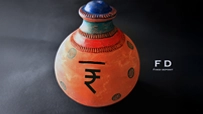Top Features and Benefits of Recurring Deposit
July 03, 2025

Disciplined saving helps in building a corpus slowly but consistently. One of the investment instruments that instills disciplined savings habit and lets your money grow over time is Recurring Deposits or RDs. They provide a flexible saving option with guaranteed returns, making them an attractive choice for many individuals.
In this article, we will explore the features and benefits of recurring deposits and how they can help you achieve your financial goals. Whether you're saving for a vacation, education, or emergency fund, understanding the flexibility of recurring deposits will empower you to make informed decisions about your savings.
Let's dive in!
Key Features of Recurring Deposits
Recurring deposits are fixed-income investments that allow you to deposit a fixed amount every month for a specific period. Here are some key features of RDs:
Low Minimum Investment
RDs have a low entry barrier, with some banks like Ujjivan allowing investments as low as ₹100 per month.
Time Period
You have the flexibility to choose the time period of your RD, starting from as little as 6 months up to 10 years. Please note that though early RD withdrawal is permissible, however, there could be a certain penalty fee, usually capped at 1% pertaining to the interest rate applicable at the time of withdrawal. Ujjivan doesn’t charge any premature RD withdrawal fee for withdrawals made after 6 months from the time of deposit.
Lock-in Period
RDs typically have a lock-in period of 30 days to 3 months, during which any premature withdrawals do not earn interest.
Premature Withdrawals
While premature withdrawals are allowed, there may be penalties levied by the bank or financial institution. Please refer to point number 2 for more information.
Loan Facility
RDs also offer the option to avail of loans against your deposit, providing liquidity when you need it the most. However, Ujjivan SFB does not offer this facility. Please contact your bank for better understanding.
Interest Calculation
RD interest in generally compounded and paid out on a quarterly basis. The interest credited adds up to the principal amount, facilitating consistent growth.
Benefits of Investing in RDs
Safe Investment
RDs are considered safe investments. Amount up to ₹5 lakh is insured under DICGC (Deposit Insurance and Credit Guarantee Corporation). Additionally, unlike mutual funds, RDs are not market-linked, meaning the interest remains fixed throughout the tenure even if there’s market downturn.
Higher Interest Rates
Recurring deposits offer higher interest rates compared to savings accounts. The rates are at par with FD rates. This helps you growing your money in a safe and secure manner. Additionally, senior citizens are eligible for higher interest rates, usually up to 0.5% over and above the normal rates.
Lump sum Pay-Out
At the end of the tenure, RDs pay out the maturity amount as a lump sum. This includes your investments and the accumulated interest, which can be used to achieve your financial goals.
Premature RD Withdrawal Facility
Let’s say you need emergency cash. You can withdraw the RD amount based on your needs. However, there could be certain terms and conditions regarding the interest rate applicable, taxability and premature withdrawal fee. Check with your bank to know the details before going for RD premature withdrawal.
Minimal Documents Required
You need to go through basic KYC process to open an RD account. If you already have a savings account with Ujjivan, you can link it to RD. The RD amount would be auto-debited from the savings account on the due date.
Easy Management
You can monitor your RD account from via net banking or bank app. You will get all the details and notifications regarding how much interest is credited and how much amount you have (principal + interest) in the bank app.
Calculating RD Interest Rates
Before investing in an RD, it's essential to understand how interest rates are calculated. The formula for calculating maturity value is as follows:
M = P*(1+R/N)^Nt, where M = Maturity amount, P = Principal amount or the installment amount, R = Interest rate in decimal, T = tenure, and N= compounding frequency (since it is usually quarterly, it will be 4). Let's consider an example to illustrate this calculation. Suppose you invest ₹5,000 per month for 3 years at an interest rate of 8%:
Using a Recurring Deposit Calculator, you will receive an interest of ₹24,094, while your maturity amount would be ₹2,04,000.
Final Thoughts
Recurring deposits provide a flexible saving option that allows you to grow your savings while earning guaranteed returns. By understanding RD features and its benefits, you can make informed decisions about your savings and achieve your financial goals efficiently.
Start small, dream big! Invest in Ujjivan Small Finance Bank’s Recurring Deposit and enjoy higher interest rates! Save for your long- and short-term goals with our RD and live a stress-free financial life. Start investing with just ₹100!
Disclaimer:
The contents herein are only for informational purposes and generic in nature. The content does not amount to an offer, invitation or solicitation of any kind to buy or sell, and are not intended to create any legal rights or obligations. This information is subject to updation, completion, amendment and verification without notice. The contents herein are also subject to other product-specific terms and conditions, as well as any applicable third-party terms and conditions, for which Ujjivan Small Finance Bank assumes no responsibility or liability.
Nothing contained herein is intended to constitute financial, investment, legal, tax, or any other professional advice or opinion. Please obtain professional advice before making investment or any other decisions. Any investment decisions that may be made by the you shall be at your own sole discretion, independent analysis and evaluation of the risks involved. The use of any information set out in this document is entirely at the user’s own risk. Ujjivan Small Finance Bank Limited makes no representation or warranty, express or implied, as to the accuracy and completeness for any information herein. The Bank disclaims any and all liability for any loss or damage (direct, indirect, consequential, or otherwise) incurred by you due to use of or due to investment, product application decisions made by you on the basis of the contents herein. While the information is prepared in good faith from sources deemed reliable (including public sources), the Bank disclaims any liability with respect to accuracy of information or any error or omission or any loss or damage incurred by anyone in reliance on the contents herein, in any manner whatsoever.
To know more about Ujjivan Small Finance Bank Products Visit:"https://www.ujjivansfb.in"
All intellectual property rights, including copyrights, trademarks, and other proprietary rights, pertaining to the content and materials displayed herein, belong
to Ujjivan Small Finance Bank Limited or its licensors. Unauthorised use or misuse of any intellectual property, or other content displayed herein is strictly prohibited and the same is not intended for distribution to, or use by, any person in any jurisdiction where such distribution or use would (by reason of that person’s nationality, residence or otherwise) be contrary to law or registration or would subject Ujjivan Small Finance Bank Limited or its affiliates to any licensing or registration requirements.
FAQs
1. Can I change the monthly instalment amount for my recurring deposit?
Generally, you cannot change your monthly RD instalment amount with Ujjivan. In case you want to change the deposit amount, you need to close your existing RD and open a new one.
2. What happens if I miss a monthly installment for my recurring deposit?
You would lose out on the potential interest earnings. As a precautionary measure, maintain sufficient balance in your account before the RD due date to avoid missed payments.
3. Can I withdraw money from my recurring deposit before the maturity date?
Yes, premature withdrawals are allowed, but there may be penalties levied by the bank. It's advisable to check with your bank regarding their specific policies. For the uninitiated, Ujjivan SFB doesn’t charge any premature withdrawal fee for withdrawals made after 6 months from the time of RD investment.
4. Are recurring deposits taxable?
Yes, the interest earned on recurring deposits is taxable as per the income tax laws in India.
5. How can I track the progress of my recurring deposit online?
Most banks offer online access to RD accounts through internet banking or mobile apps. You can log in and view your account details and progress.
6. Is there a minimum limit for investing in recurring deposits?
You can start investing in Ujjivan’s Recurring Deposit with as low as ₹100. However, it’s essential to invest larger amounts for higher returns.
7. Are senior citizens eligible for higher interest rates on recurring deposits?
Yes, Ujjivan offers higher interest rates for senior citizens. It’s usually 0.5% higher than the normal interest rates.
Latest Blogs

Dussehra 2025: How to Win Your Financial Battles with Smart Saving
Dussehra 2025 (also known as Vijayadashami) falls on Thursday, October 2, 2025.

eSIM Scam in India: I4C Warns Mobile Users About Rising Fraud – How to Stay Safe
The Indian Cybercrime Coordination Centre (I4C), a wing of the Ministry of Home Affairs, issued a strong warning to mobile users about the rapid increase in eSIM fraud in India.

How to Link PAN with Aadhaar: Step-by-Step Guide & Consequences of Not Linking
Linking your Permanent Account Number (PAN) with your Aadhaar is no longer just a best practice.

Annual Information Statement (AIS): A Complete Guide for Stress-Free ITR Filing
India’s tax season is in its final stretch.

ITR-1 (Sahaj) Restrictions: Income Sources Not Allowed & Filing Rules
With just a few days left before the 15 September 2025 deadline for filing Income Tax Returns (ITRs) for Assessment Year (AY) 2025-26, many taxpayers are rushing to submit their forms online.





